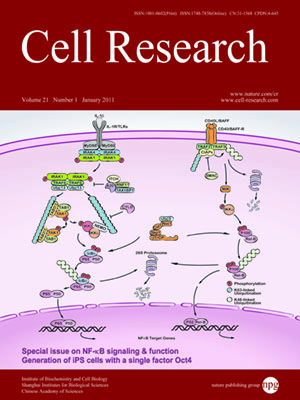
Volume 21, No 1, Jan 2011
ISSN: 1001-0602
EISSN: 1748-7838 2018
impact factor 17.848*
(Clarivate Analytics, 2019)
Volume 21 Issue 1, January 2011: 131-145
REVIEWS
Regulation and function of TPL-2, an IκB kinase-regulated MAP kinase kinase kinase
Thorsten Gantke, Srividya Sriskantharajah and Steven C Ley
Division of Immune Cell Biology, National Institute for Medical Research, Mill Hill, London, NW7 1AA, UK
Correspondence: Steven C Ley,(Steven C Ley,)
The IκB kinase (IKK) complex plays a well-documented role in innate and adaptive immunity. This function has been widely attributed to its role as the central activator of the NF-κB family of transcription factors. However, another important consequence of IKK activation is the regulation of TPL-2, a MEK kinase that is required for activation of ERK-1/2 MAP kinases in myeloid cells following Toll-like receptor and TNF receptor stimulation. In unstimulated cells, TPL-2 is stoichiometrically complexed with the NF-κB inhibitory protein NF-κB1 p105, which blocks TPL-2 access to its substrate MEK, and the ubiquitin-binding protein ABIN-2 (A20-binding inhibitor of NF-κB 2), both of which are required to maintain TPL-2 protein stability. Following agonist stimulation, the IKK complex phosphorylates p105, triggering its K48-linked ubiquitination and degradation by the proteasome. This releases TPL-2 from p105-mediated inhibition, facilitating activation of MEK, in addition to modulating NF-κB activation by liberating associated Rel subunits for translocation into the nucleus. IKK-induced proteolysis of p105, therefore, can directly regulate both NF-κB and ERK MAP kinase activation via NF-κB1 p105. TPL-2 is critical for production of the proinflammatory cytokine TNF during inflammatory responses. Consequently, there has been considerable interest in the pharmaceutical industry to develop selective TPL-2 inhibitors as drugs for the treatment of TNF-dependent inflammatory diseases, such as rheumatoid arthritis and inflammatory bowel disease. This review summarizes our current understanding of the regulation of TPL-2 signaling function, and also the complex positive and negative roles of TPL-2 in immune and inflammatory responses.
Cell Research (2011) 21:131-145. doi:10.1038/cr.2010.173; published online 7 December 2010
FULL TEXT | PDF
Browse 2043


